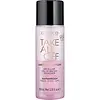Essence The Nail Repair Oil Versus Catrice Take All Off Anti-Pollution Micellar Oil-in-Water Remover
What's inside
What's inside
 Key Ingredients
Key Ingredients

No key ingredients
 Benefits
Benefits

 Concerns
Concerns

 Ingredients Side-by-side
Ingredients Side-by-side

Prunus Amygdalus Dulcis Oil
Skin ConditioningHydrogenated Farnesene
EmollientLens Esculenta Seed Extract
Skin ProtectingTocopherol
AntioxidantPrunus Armeniaca Kernel Oil
MaskingArgania Spinosa Kernel Oil
EmollientHelianthus Annuus Seed Oil
EmollientCaprylic/Capric Triglyceride
MaskingChenopodium Quinoa Seed Extract
Skin ConditioningSqualane
EmollientAlcohol
AntimicrobialHydrolyzed Cicer Seed Extract
Skin ProtectingAscorbyl Palmitate
AntioxidantAscorbic Acid
AntioxidantBenzotriazolyl Dodecyl P-Cresol
UV AbsorberCitric Acid
BufferingParfum
MaskingPrunus Amygdalus Dulcis Oil, Hydrogenated Farnesene, Lens Esculenta Seed Extract, Tocopherol, Prunus Armeniaca Kernel Oil, Argania Spinosa Kernel Oil, Helianthus Annuus Seed Oil, Caprylic/Capric Triglyceride, Chenopodium Quinoa Seed Extract, Squalane, Alcohol, Hydrolyzed Cicer Seed Extract, Ascorbyl Palmitate, Ascorbic Acid, Benzotriazolyl Dodecyl P-Cresol, Citric Acid, Parfum
Water
Skin ConditioningCyclopentasiloxane
EmollientPoloxamer 184
EmulsifyingGlycerin
HumectantPrunus Serrulata Flower Extract
Skin Conditioning1,2-Hexanediol
Skin ConditioningSodium Chloride
MaskingDisodium EDTA
PPG-26-Buteth-26
Skin ConditioningPEG-40 Hydrogenated Castor Oil
EmulsifyingXanthan Gum
EmulsifyingPaeonia Lactiflora Root Extract
Skin ConditioningSodium Citrate
BufferingCitric Acid
BufferingBenzyl Alcohol
PerfumingPhenoxyethanol
PreservativeIngredients Explained
These ingredients are found in both products.
Ingredients higher up in an ingredient list are typically present in a larger amount.
Citric Acid is an alpha hydroxy acid (AHA) naturally found in citrus fruits like oranges, lemons, and limes.
Like other AHAs, citric acid can exfoliate skin by breaking down the bonds that hold dead skin cells together. This helps reveal smoother and brighter skin underneath.
However, this exfoliating effect only happens at high concentrations (20%) which can be hard to find in cosmetic products.
Due to this, citric acid is usually included in small amounts as a pH adjuster. This helps keep products slightly more acidic and compatible with skin's natural pH.
In skincare formulas, citric acid can:
While it can provide some skin benefits, research shows lactic acid and glycolic acid are generally more effective and less irritating exfoliants.
Most citric acid used in skincare today is made by fermenting sugars (usually from molasses). This synthetic version is identical to the natural citrus form but easier to stabilize and use in formulations.
Read more about some other popular AHA's here:
Learn more about Citric Acid